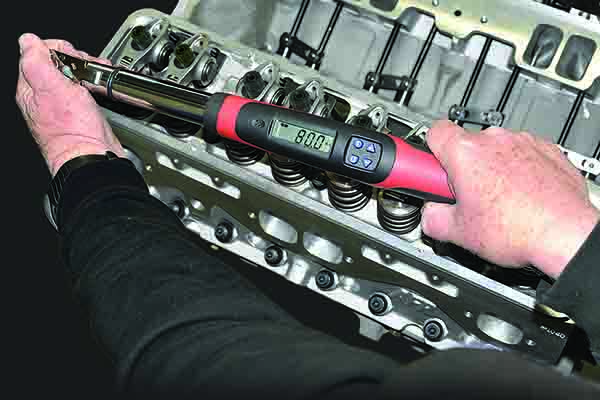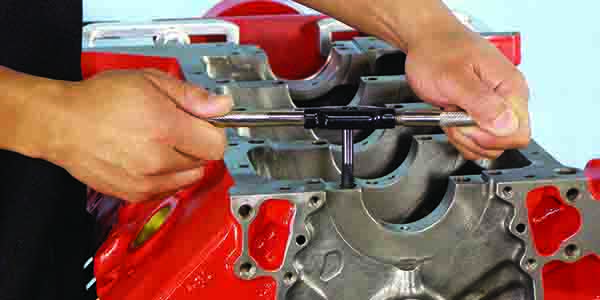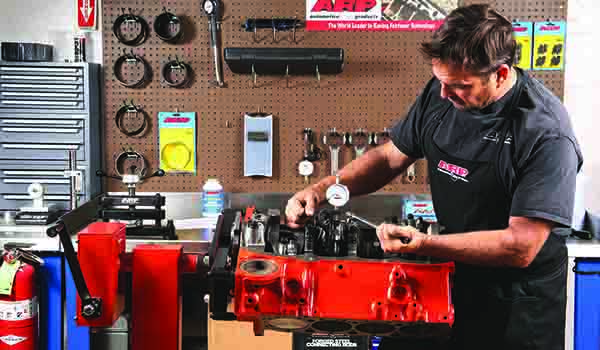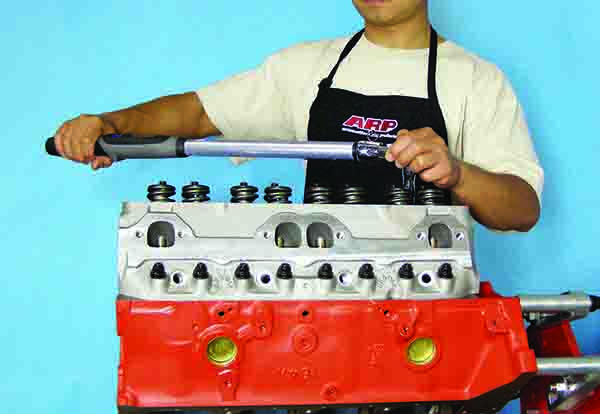We know that fasteners hold an engine together. And that fasteners play a critical role in an engine’s reliability – especially when engines are pushed to higher performance levels. How then do we get the most out of them?
At ARP, we work closely with leading race teams (Formula 1, NASCAR and NHRA to name a few). If anyone can abuse a fastener, it’s a racer!

The first thing that should be understood is that a fastener acts much like a spring, in as much as it must be stretched in order to provide clamping force. The higher the preload, the more force is applied through this stretch. A common 3/8˝ small block Chevy rod bolt, by way of example, will generate about 10,000 psi preload when stretched to 0.0055˝ to 0.0060˝. Of course, you simply can’t crank up the preload on any fastener as factors like material, heat-treat and diameter are at play.
Applying the correct preload is, of course, critically important. With a rod bolt this is easy to verify through use of a stretch gauge. And since connecting rod bolts are the most critical in any engine, given that failure here can lead to massive carnage, it’s a “must” for any serious high performance build.
Without the ability to monitor a fastener’s stretch – which is the case for most others, as they’re installed “blind” – you’re probably relying on a torque wrench instead of a torque angle gauge/meter typically employed with TTY (Torque-To-Yield) fasteners. Proper preload is of paramount importance.
Herein lies the biggest challenge to an engine builder; eliminating the “preload scatter” that occurs due to the condition of the threads, the spot face of the surface being clamped, type of lubricant used, and the accuracy of the torque wrench itself. (Note: ARP has offered racers free torque wrench testing at all NHRA national events for many years and we’ve discovered that a large percentage of the torque wrenches tested were inaccurate – some by as much as 30 percent). It’s good practice to have torque wrenches calibrated periodically. They should always be handled with kid gloves, as they are delicate instruments and should never be tossed around or used like a breaker bar to loosen fasteners.

Many builders rely on torque wrench readings as the absolute gospel; you set the wrench to a predetermined value and when it goes “click” the fastener is properly preloaded. But that’s often not the case, as irregularities in the threads, the spot face and the fastener lubricant itself can cause friction. Ergo, a portion of the energy thought to be preloading a fastener is actually expended overcoming friction. Moreover, this disparity can vary from fastener to fastener, and when adjacent fasteners are preloaded unevenly (as is often the case with head and main bolts or studs) it can actually distort a cylinder bore and affect optimum piston ring sealing or the main caps and affect bearing clearances.
It is possible to mitigate the disparities served up by the lubricant and thread anomalies through torqueing, loosening and then re-torqueing a fastener through multiple cycles – sometimes up to eight or more times – to “burnish” the threads, spot face and overcome lubricant friction. But this is obviously a time-consuming task that costs any professional money and not very accurate in the end.
ARP has done extensive testing of fastener preloads using sophisticated computer-controlled equipment and determined how oil, moly, EPL, “peanut butter,” and other substances perform. They have documented substantial differences in how much actual preload is transferred to the fastener, and how many cycles it takes to normalize.
On the first pull of the torque wrench, oil can have a disparity of some 25% from desired preload to actual preload.
As a result of years of testing, ARP has developed its Ultra-Torque fastener lubricant. It’s proven to deliver 95-100% of the desired preload on the first (and any subsequent) pull. This is a boon to professionals seeking to do the best possible job without wasted motion.

When applying any fastener lubricant it’s important to do more than just the threads. The area under the head of a bolt or nut, as well as the threads, should be well lubricated.
The condition of threads in the block and cylinder head are also instrumental in obtaining the desired fastener preload. ARP’s tech staff cautions that ordinary taps should not be employed to clean up the threads, as they’ll likely cut into the thread and affect engagement. Instead, use special “chaser” taps that are designed for the task. Afterwards, a thorough washing of each hole is in order. But you knew that.
Another question that comes up relates to fastener re-use. The TTY bolts employed by the majority of automakers for the past 30 years or so are designed to be yielded. TTY bolts are typically installed by robotic equipment to 90-120 percent of yield.
This is certainly adequate for a stock application. But if the engine is modified to any real extent you’re asking for trouble. What’s more, because these fasteners are yielded by design they should not be re-used. Once yielded, a fastener’s ability to properly provide clamping force in a second usage has been severely compromised Our high performance fasteners are engineered to provide a 25-30 percent safety margin, so they can be re-used over and over.”

When should a critical fastener be replaced? Rod bolts are considered to be the most at-risk in an engine. We advocate measuring the length of each rod bolt prior to assembly and making note of it. Upon disassembly of the engine, measure them again. If any measure 0.001˝ or more longer than their original length they should be replaced.
OEM rod bolts should be replaced with stronger versions that use a higher preload. It’s important to resize the rod using the new bolts as the increased preload can affect bearing clearances. The same thing applies to main cap bolts and studs, as the increased clamping load can distort the cap and require align honing the block using the new fasteners with increased preload.
One other word of caution relates to the use of anaerobic cements which can set up quickly. If too much time passes between putting the cement on the fastener and torquing flywheel or flexplate bolts it can cause great inaccuracies.
The right fasteners, installed the right way, can enhance the quality of any build.
Bob Florine is president of ARP Fasteners. For more information, visit
www.arp-bolts.com













